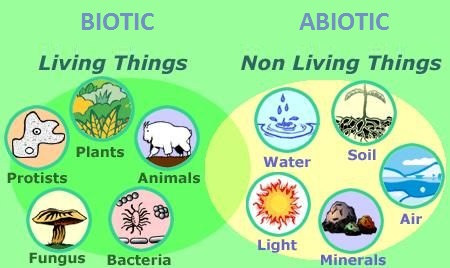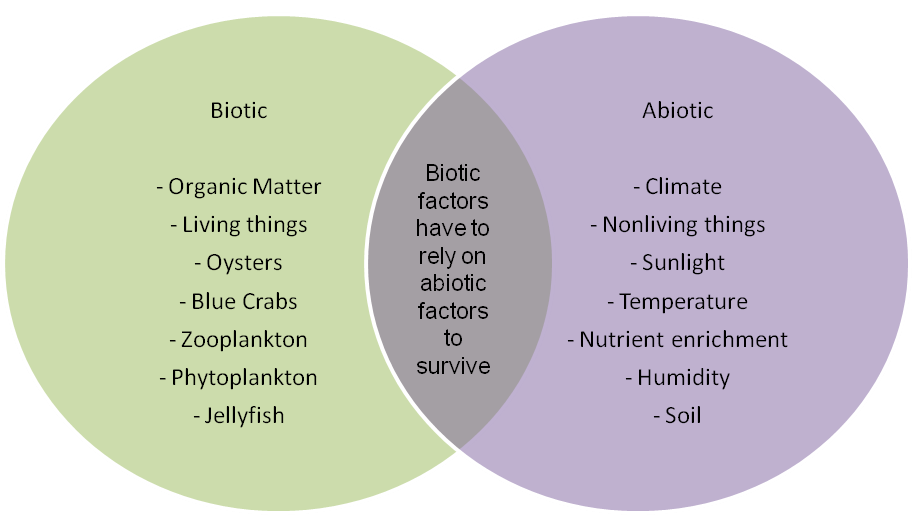Topic abiotic factors of the ecosystem: Explore the pivotal role of abiotic factors in ecosystems, understanding how elements like sunlight, water, and soil shape the environment and support diverse life forms.
Table of Content
- What are the main abiotic factors of the ecosystem?
- Understanding Abiotic Factors
- Types of Abiotic Factors
- Role of Temperature and Sunlight
- Importance of Water and Air
- Soil Composition and Structure
- Impact of Climate and Weather
- YOUTUBE: Abiotic Factors in Ecosystems: Water
- Chemical Factors: pH, Minerals, and Nutrients
- Abiotic Stressors and Ecosystem Resilience
- Human Impact on Abiotic Factors
- Conservation and Management of Abiotic Resources
What are the main abiotic factors of the ecosystem?
The main abiotic factors of an ecosystem include:
- Temperature: The average temperature of the area can have a significant impact on the organisms living in the ecosystem. Extreme temperatures can limit the survival and reproduction of many species.
- Water availability: The amount and availability of water in an ecosystem is crucial for the survival of organisms. It determines the distribution of species and plays a vital role in their physiological processes.
- Light: The intensity, duration, and quality of light in an ecosystem influence the growth and development of plants and other photosynthetic organisms. It also affects the behavior and activity patterns of many animals.
- Soil composition: The composition of soil, including its texture, nutrient content, and pH, affects the types of plants that can grow in an area. It also influences the organisms that depend on the soil for survival.
- Topography: The physical features of the land, such as mountains, valleys, and slopes, influence the distribution of organisms in an ecosystem. These factors can affect the flow of water, movement of air, and availability of resources.
- Atmospheric conditions: Factors like wind, humidity, and air pressure can impact the local climate and influence the ecology of an area. They can affect the dispersal of seeds, pollination, and the behavior of organisms.
- Chemical factors: Various chemical elements and compounds present in the environment, such as oxygen, carbon dioxide, and pollutants, have a direct or indirect influence on the organisms in an ecosystem.
These abiotic factors interact with each other and with the biotic factors (living organisms) to create and maintain the unique characteristics of a particular ecosystem.
READ MORE:
Understanding Abiotic Factors
Abiotic factors are the non-living components that shape ecosystems and influence the survival and growth of living organisms. These factors play a crucial role in determining the structure and function of ecosystems by directly affecting the availability of resources, habitat conditions, and the life cycles of organisms.
- Temperature: A key determinant of habitat suitability for different species, affecting metabolic rates and biological processes.
- Light: Essential for photosynthesis, determining plant growth and energy flow in ecosystems.
- Water: A fundamental resource for all living beings, influencing species distribution and ecosystem dynamics.
- Soil: Composed of minerals, organic matter, and nutrients, soil supports plant life and influences vegetation types.
- Atmospheric Gases: Oxygen, carbon dioxide, and nitrogen are crucial for respiration, photosynthesis, and nitrogen fixation.
- Wind: Affects pollination, seed dispersal, and temperature regulation.
- pH Levels: Influences nutrient availability and species composition in both soil and water ecosystems.
Understanding these abiotic factors is essential for grasping how ecosystems function and for the effective management and conservation of natural habitats.

Types of Abiotic Factors
Abiotic factors are diverse and can be categorized based on their nature and the way they influence ecosystems. These factors are essential in shaping the physical environment and providing the necessary conditions for life.
- Climatic Factors: Include sunlight, temperature, precipitation, and wind, which directly affect the survival and distribution of organisms.
- Edaphic Factors: Related to soil, such as soil texture, structure, pH, and mineral content, influencing plant growth and microbial activities.
- Topographic Factors: Landscape features like elevation, slope, and aspect, which can modify the local climate within an ecosystem.
- Hydrologic Factors: Concern water bodies and their properties, including salinity, pH, flow rate, and water availability.
- Chemical Factors: Encompass the concentration of nutrients and chemicals, such as oxygen, carbon dioxide, nitrogen, and phosphorus, that are crucial for life.
Each of these factors plays a unique role in ecosystem dynamics, affecting the distribution, behavior, and adaptation of organisms. By understanding the types of abiotic factors, we can better appreciate the complexity and interconnectivity of natural systems.
Role of Temperature and Sunlight
Temperature and sunlight are pivotal abiotic factors that significantly influence ecosystem dynamics, organism behaviors, and biodiversity. Their effects permeate through ecosystems, shaping life in profound ways.
- Temperature: Regulates biological processes and metabolic rates. It influences growth, reproduction, and survival rates of organisms. Temperature gradients lead to the formation of different biomes, each supporting unique life forms adapted to their thermal environment.
- Sunlight: Drives photosynthesis, the foundational process for energy production in ecosystems. Sunlight affects plant growth patterns, photoperiodism, and feeding behaviors of animals. The distribution and intensity of sunlight also determine the stratification of habitats, such as in aquatic environments where light penetration influences the distribution of photosynthetic zones.
Together, temperature and sunlight dictate seasonal cycles, geographic distribution of species, and the overall productivity of ecosystems. By moderating these factors, we see a direct impact on ecological balance and biodiversity. Understanding their roles helps in predicting changes in ecosystems due to global climate change and in devising conservation strategies.

Importance of Water and Air
Water and air are fundamental abiotic factors that sustain life on Earth, underpinning the survival of all ecosystems. Their significance cannot be overstated, as they are critical for both physiological processes and the maintenance of habitat conditions.
- Water: Essential for life, water is involved in nearly every biological process. It is a solvent for biochemical reactions, a means of nutrient transport, and a temperature regulator. In ecosystems, water availability directly influences species distribution, plant productivity, and the structure of communities.
- Air: Comprising primarily nitrogen, oxygen, carbon dioxide, and other gases, air is crucial for respiration, photosynthesis, and transpiration. The quality of air affects the health of ecosystems and the organisms within them. Pollutants in the air can disrupt these processes and harm life.
The interaction between water and air also drives global climate patterns and weather, affecting ecosystems at both local and global scales. Protecting these vital resources is essential for preserving biodiversity and ensuring the health of our planet.
Soil Composition and Structure
Soil is a critical abiotic factor that supports life on Earth, acting as a medium for plant growth, a habitat for numerous organisms, and a key component in nutrient cycling. Understanding its composition and structure is vital for grasping its role in ecosystems.
- Composition: Soil consists of minerals (sand, silt, and clay), organic matter (decomposed plants and animals), water, and air. The balance of these components determines the soil"s physical properties and fertility.
- Structure: Soil structure refers to the arrangement of soil particles into aggregates. These aggregates create spaces (pores) for air and water, crucial for root growth and microbial activity. Good structure enhances water infiltration, nutrient uptake, and aeration.
- pH Level: The pH of soil affects the availability of nutrients to plants and the activity of soil organisms. Soils can range from very acidic to very alkaline, influencing the types of plants that can grow.
- Nutrient Content: Essential nutrients like nitrogen, phosphorus, and potassium are found in soil and are vital for plant growth. The availability of these nutrients can be affected by factors such as pH, organic matter content, and microbial activity.
The health and composition of soil are critical for ecosystem productivity and resilience. Conservation efforts often focus on maintaining soil health through practices that prevent erosion, enhance organic matter, and restore degraded lands.

Impact of Climate and Weather
Climate and weather play a critical role in shaping ecosystems by influencing temperature, precipitation patterns, and other atmospheric conditions. These abiotic factors directly affect the distribution, behavior, and survival of species within ecosystems.
- Temperature and precipitation determine the geographical distribution of biomes, such as forests, deserts, and grasslands.
- Climate change has led to shifts in weather patterns, including more extreme weather events like hurricanes, droughts, and heavy rainfall, which have profound impacts on ecosystems and biodiversity.
- Rising global temperatures are affecting ocean ecosystems by increasing sea surface temperatures, leading to coral bleaching and affecting marine biodiversity.
- Changes in climate and weather patterns also impact the hydrological cycle, influencing water availability for terrestrial and aquatic ecosystems.
- Mountainous regions experience distinct climate zones at different elevations, affecting the types of vegetation and animal life that can thrive in these areas.
- Climate change is causing shifts in the timing of seasonal events (phenology), such as flowering and migration, which can disrupt ecological interactions.
The impacts of climate and weather on ecosystems underscore the importance of understanding and mitigating climate change to protect biodiversity and ensure the resilience of ecosystems.
Abiotic Factors in Ecosystems: Water
Discover the fascinating world of water in our video! Dive deep into the wonders of this life-giving element as we explore its importance, beauty, and surprising secrets. Join us on this immersive journey and unlock the true power of water!
Abiotic Factors in Ecosystems: Soil and Minerals
Journey with us into the rich depths of soil and minerals in our captivating video! Unveil the hidden treasures beneath our feet as we unravel the science, nourishment, and breathtaking beauty found in every grain of soil and diverse array of minerals. Immerse yourself in this enlightening exploration and be amazed by the wonders that lie beneath the surface!
Chemical Factors: pH, Minerals, and Nutrients
Chemical factors, including pH, minerals, and nutrients, are fundamental abiotic components that influence ecosystem health and productivity. These elements affect the water quality, soil fertility, and overall biodiversity of an ecosystem.
- pH Levels: The acidity or alkalinity of soil and water can significantly impact plant growth and microbial activity. pH levels can influence the solubility of minerals in the soil, affecting nutrient availability to plants and the composition of aquatic and terrestrial habitats.
- Minerals: Essential minerals such as nitrogen, potassium, and phosphorus serve as nutrients that support the growth and development of plants. The presence and balance of these minerals in the ecosystem play a crucial role in maintaining the health of flora and fauna.
- Nutrients: Nutrients are vital for the growth of organisms within an ecosystem. The cycling of nutrients, including carbon, nitrogen, and phosphorus, through soil, water, and organisms, is a key process that sustains life.
Understanding the interaction between these chemical factors and living organisms is critical for conserving biodiversity and ensuring ecosystem resilience. Managing pH levels, mineral content, and nutrient cycles is essential for sustainable ecosystem management and the preservation of natural habitats.

Abiotic Stressors and Ecosystem Resilience
Abiotic stressors refer to non-living factors that can have a profound impact on ecosystems. These stressors include extreme temperatures, drought, flooding, and pollution. Ecosystem resilience is the ability of an ecosystem to absorb such disturbances and reorganize while undergoing change to still retain essentially the same function, structure, identity, and feedbacks.
- Extreme Temperatures: Both high and low temperatures can stress ecosystems. High temperatures can lead to heat stress in plants and animals, while low temperatures can cause frost damage and inhibit growth.
- Drought: Lack of water availability can lead to drought stress, affecting plant growth, reducing water availability for animals, and altering nutrient cycles.
- Flooding: Excessive water due to flooding can lead to anoxic conditions for plant roots, disrupt habitats for terrestrial animals, and wash away fertile soil.
- Pollution: Chemical pollutants can degrade water and soil quality, affecting the health and diversity of both aquatic and terrestrial life.
Ecosystem resilience is enhanced through biodiversity, as diverse ecosystems are better equipped to withstand environmental stressors. Adaptation strategies, such as conservation efforts, restoration projects, and sustainable management practices, are vital for enhancing the resilience of ecosystems to abiotic stressors.
Human Impact on Abiotic Factors
Human activities have significantly impacted abiotic factors in ecosystems worldwide, altering water, soil, air, and climate conditions. These changes not only affect the health and functioning of natural ecosystems but also have far-reaching effects on biodiversity and the global environment.
- Climate Change: The release of greenhouse gases from burning fossil fuels has led to global warming, affecting weather patterns, increasing temperatures, and altering precipitation regimes.
- Pollution: Industrial, agricultural, and urban activities release pollutants into the air, water, and soil. These pollutants can degrade habitat quality, affect water pH, and lead to nutrient imbalances.
- Land Use Change: Deforestation, urbanization, and agriculture change the landscape, affecting local climates, soil erosion rates, and water cycles.
- Water Use: Overextraction of water for agriculture, industry, and domestic use alters hydrological systems, affecting water availability and leading to habitat loss in aquatic ecosystems.
To mitigate human impacts on abiotic factors, sustainable practices and policies are essential. Efforts include reducing greenhouse gas emissions, managing natural resources responsibly, restoring degraded ecosystems, and adopting clean technologies. Addressing these challenges is crucial for preserving ecosystem integrity and ensuring a sustainable future for all species, including humans.

READ MORE:
Conservation and Management of Abiotic Resources
Conservation and management of abiotic resources are crucial for sustaining ecosystem health and resilience. Abiotic resources, including water, minerals, and climate, form the foundation of all ecosystems. Effective strategies aim to preserve these resources, ensuring their availability for future generations while maintaining ecological balance.
- Water Conservation: Implementing efficient water use practices, protecting watersheds, and restoring wetlands are vital for maintaining the hydrological cycle and supporting aquatic and terrestrial life.
- Soil Management: Sustainable farming practices, such as crop rotation, no-till agriculture, and the use of organic fertilizers, help maintain soil fertility, prevent erosion, and reduce the need for chemical inputs.
- Air Quality: Reducing emissions from industrial and vehicular sources, along with planting trees and preserving green spaces, can improve air quality and mitigate the impacts of climate change.
- Climate Regulation: Efforts to reduce greenhouse gas emissions through renewable energy sources, energy efficiency, and carbon sequestration practices are critical for managing global climate systems.
- Mineral Conservation: Recycling, efficient use of minerals, and the development of sustainable mining practices are important for ensuring the availability of essential minerals for technological and industrial processes.
Collaborative international and local policies, along with community engagement and education, are key to the effective conservation and management of abiotic resources. By prioritizing sustainability, societies can protect these vital components of the ecosystem, supporting biodiversity and human well-being alike.
Discover the vital role of abiotic factors in shaping ecosystems and learn how conservation and sustainable management can preserve these essential elements for future generations. Explore the fascinating interplay between non-living components and life on Earth.




